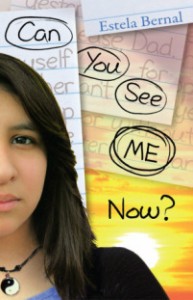I met Estela Bernal at a novel revision workshop led by the wise and generous Barbara Seuling. Estela and I shared a room and she told me about her work rescuing abused animals and educating people about responsible pet ownership. At the workshop we read each other’s full manuscripts, and I could not get hers—the story of a girl who loses her father to a drunk driver on her thirteenth birthday—out of my mind. I wondered what happened to her story.
 My question was answered when Rich in Color announced the publication this spring of Can You See Me Now? And to my delight, the paperback from Arte Público Press’s Piñata Books imprint was waiting for me when I got home from a week and a half as a graduate assistant at Vermont College of Fine Arts. Since I had recommended Piñata Books to Estela as a place to send her manuscript after she’d finished the revision, I felt especially gratified.
My question was answered when Rich in Color announced the publication this spring of Can You See Me Now? And to my delight, the paperback from Arte Público Press’s Piñata Books imprint was waiting for me when I got home from a week and a half as a graduate assistant at Vermont College of Fine Arts. Since I had recommended Piñata Books to Estela as a place to send her manuscript after she’d finished the revision, I felt especially gratified.
Because I know the author and the project so well, this won’t be a traditional review but a commentary on what small presses and authors who are cultural insiders can offer. Can You See Me Now? is not autobiographical, but Estela’s own roots in a small town populated by Hispanic residents who have lived there for many generations give the setting depth, as if it’s a character in the story. It also challenges the stereotype of Latinos as recent immigrants or having lived in the United States for no more than two or three generations. There are many people in the Southwest and West whose families have lived in that area since before 1848 when the United States seized those lands from Mexico.
This invisible history subtly informs the story about a young teenager who feels invisible in her grief. Her mother, also grieving, takes on extra shifts at work, leaving young Amanda (Mandy) in the care of her grandmother. The school bullies cut her no slack—just days after she returns to school, they glue her skirt to the chair. A local history project leads Mandy to Paloma, another “invisible” girl whose hippie parents, studious demeanor, and interest in yoga knock her off the social radar. Mandy also realizes her own complicity in marginalizing other students when the house across the street from her grandmother’s burns down, and she discovers that the fat boy who lives there has been her classmate for years but she has never spoken to him. Now she does, and it leads to another friendship both with him and with his dog.
I frequently attend national library and language arts conferences, and while I’m there I stop by the Arte Público booth. I’ve noticed how other conference-goers turn up their noses at this small press booth on their way to the elaborate displays and high-profile book signings at the Big 5 areas. At a BEA panel on multicultural publishing with Cheryl Willis Hudson of Just Us Books and John Byrd of Cinco Puntos Press this past May, I learned that nearly half of all the multicultural books counted by the Cooperative Children’s Book Center are published by small presses. These are books written by authors who are cultural insiders and feature experiences and themes that go beyond the media stereotypes. While we should support diverse books and authors published by the major houses (including our very own Varian Johnson whose delightful middle grade novel The Great Greene Heist has garnered much critical acclaim) and push them to do more, we should not ignore those small presses that have shown commitment to their authors and their communities for decades.
* * *
A good place to find out about outstanding multicultural, international, and environmental books, most of them published by small presses, is the Skipping Stones Honor Awards. The 2014 awards have just been announced, and are available here.
1 comment for “Making the Invisible Visible: Estela Bernal’s Can You See Me Now?”